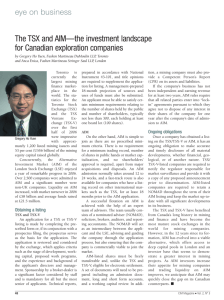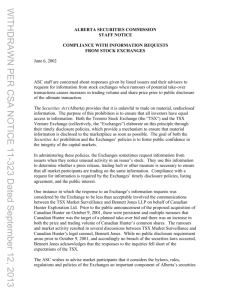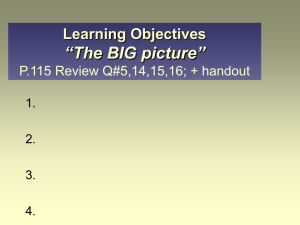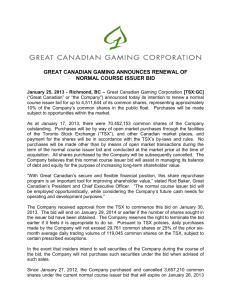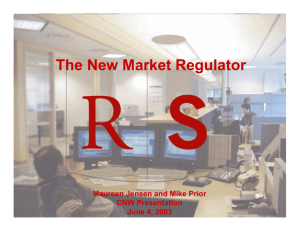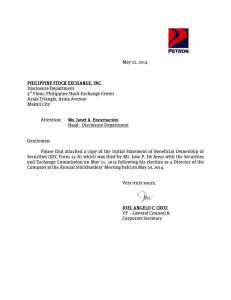Mining the Field
advertisement
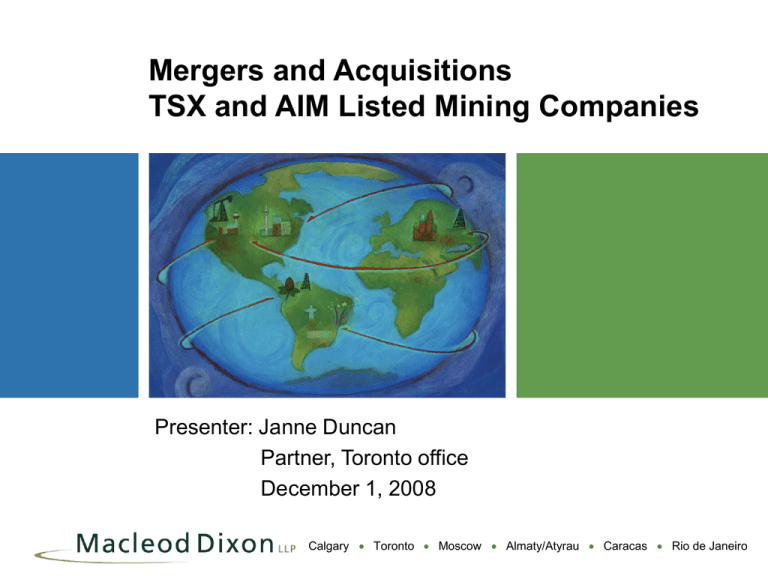
Mergers and Acquisitions TSX and AIM Listed Mining Companies Presenter: Janne Duncan Partner, Toronto office December 1, 2008 Calgary Toronto Moscow Almaty/Atyrau Caracas Rio de Janeiro Agenda • Dealing with dual-listed companies – Toronto Stock Exchange (TSX), Canada’s senior exchange, or TSX Venture Exchange (TSX-V), Canada’s junior exchange – AIM • Choosing the path for a merger & acquisition – Take-over Bid – Reverse Take-over – Plan of Arrangement Pre-Merger Considerations • Where investors are located – U.K. investors may continue to require AIM listing – Liquidity issues • AIM tends to have more institutional, less retail, long-term investors • On-going expenses – underwriting, legal (all applicable jurisdictions), audit, registrar and transfer fees, fees to stock exchanges, fees to securities regulators NOMADs – an additional cost for AIM-listed companies • AIM – Every AIM-listed company must have a: – NOMAD (Nominated Advisor) – • IPO stage – conducts extensive due diligence; guides company through the admission process • Post-Admission stage – provides advice on continuing obligations under AIM and to the investors; monitors the company (policing role) – Broker – brings together buyers and sellers – NOMAD and Broker can be performed by single firm (dual roles policing/selling sometimes impractical) – Expensive to split NOMAD and Broker role between two firms Doubling up • Corporate governance (more problematic if companies subject to U.K. company law) • Continuous disclosure obligations • Regulatory compliance • Check to see if there are exemptions under various rules for foreign issuers Exemptions for Inter-listed Companies • TSX will not require security holder approval for new issuances, private placements, unlisted warrants, and security based compensation arrangements from issuers listed on another exchange where at least 75% of the trading value and volume over the six months immediately preceding notification occurs on that other exchange. • AIM does not have equivalent exemption Timely Disclosure – National Instrument 71-102 – Continuous Disclosure and Other Exemptions Relating to Foreign Issuers “Designated foreign reporting issuers” – an issuer that qualifies as a foreign reporting issuer (see below), and • is not registered or required to file reports under the U.S. 1934 Act, and • not more than 10% of the equity securities are held by Canadians • is subject to the reporting requirements of any of the following jurisdictions: Australia, France, Germany, Hong Kong, Italy, Japan, Mexico, the Netherlands, New Zealand, Singapore, South Africa, Spain, Sweden, Switzerland, U.K. “foreign reporting issuers” – an issuer incorporated or organized outside of Canada, unless • more than 50% of the shareholders are Canadian residents • a majority of officers/directors are resident in Canada • more than 50% assets are in Canada, or • business is administered principally in Canada Corporate Governance - Canada • Canada is moving closer to U.S. rules on the following matters: – – – – Board independence Audit committee independence CEO/CFO SOX certifications Executive compensation • Canada is less litigious than U.S. • Canadian corporate governance is less “rules based” (lengthy, prescriptive rules) and more “principles-based” (regulators prescribe “best practices” and issuers inform investors whether they comply, and if not, why not) Corporate Governance - UK • AIM – companies listed on AIM are not subject to the UK’s Combined Code (UK Combined Code applies only to the London Stock Exchangelisted companies) – voluntary corporate governance guidelines published by Quoted Companies Alliance (QCA), although best practice is to comply with the UK Combined Code as closely as possible Comparison of Continuous Obligations for Maintaining Listing on TSX / TSX-V and AIM Requirement TSX/TSX-V AIM Press Release For material changes that would affect share price, file immediately For material changes that would affect share price, file immediately Material Change Report File within 10 days of a material change Not Applicable Early Warning Reports Shareholder to immediately notify market when shareholdings reach 10% and thereafter every time an additional 2% is acquired Company to notify market as soon as it is notified of any shareholder exceeding or falling below 3% Significant Acquisition Report Business acquisition report filed within 75 days of acquisition if pass one of three tests for significant acquisition Notification of substantial transactions which exceed 10% of any specified class tests e.g. assets Communications with Shareholders Management information circular and form of proxy to be filed and delivered to shareholders in connection with shareholder meetings Canadian documentation to be filed and made available to shareholders Comparison of Continuous Obligations for Maintaining Listing on TSX / TSX-V vs AIM Contd… Requirement TSX/TSX-V AIM Annual Information Form (supports accelerated prospectus offerings) File within 90 days of financial year end, accompanied by material contracts. Not required by TSX-V but file material contracts within 120 days of year end. Not Required CEO & CFO Certification Concurrently with annual and quarterly filings Not Required Interim Financial Statements File quarterly with Management’s Discussion and Analysis (MD&A) 45 days after quarter end for TSX, 60 days for TSX-V or date of filing in foreign jurisdiction Filed every 6 months within 3 months of period end. Canadian quarterly financials suffice, but must be filed at same time as Canadian financials. No MD&A Annual Financials File financial statements and MD&A within 90 days of financial year end (concurrent with AIF) or date of filing in foreign jurisdiction Filing required within six months of financial year end (Canadian GAAP acceptable) No MD&A Comparison of Continuous Obligations for Maintaining Listing on TSX / TSX-V vs AIM Contd… Requirement TSX/TSX-V AIM Insider Reporting Insiders (directors, officers and 10% shareholders) to file insider report within 10 calendar days of becoming an insider and within 10 days of any subsequent transaction. Company to notify market as soon as issuer “becomes aware” of trading by directors. Insider Trading Prohibition against trading with knowledge of undisclosed material fact or material change. Restrictions on trading by persons in “special relationships” Prohibition against trading with knowledge of undisclosed price sensitive information. Share Compensation Plan Disclosure Annually disclosed and shareholder approval required for plan and/or amendments to plan Not mandatory Audit Committee TSX requires fully independent audit committee while TSX-V does not. Not mandatory Comparison of Continuous Obligations for Maintaining Listing on TSX / TSX-V vs AIM Contd… Requirement TSX/TSX-V AIM Notice and Approval of New Issuances For all new issuances of securities other than unlisted, non-voting, non-participating securities including private placements, unlisted warrants, and security based compensation plans Any change in the number of AIM securities in issue requires liaising with Issuer Implementation the day before new issuance Security Holder Approval Required if the proposed transaction materially affects control of the listed issuer; or provides consideration to insiders in aggregate of 10% or greater of the market capitalization of the listed issuer and has not been negotiated at arm's length. None Blackout Periods • Blackout periods - prevent directors, officers and insiders from trading with knowledge of material nondisclosed information • TSX/TSX-V – typically, scheduled black-outs start the first day of a new financial quarter and end when financial statements for the previous financial quarter are released • AIM – if company reports half yearly, insiders may not trade for the two months preceding the notification of its half-yearly report • Compliance with both regimes creates issues for insiders trying to exercise options (even if hold underlying stock) National Instrument 43-101 of the Canadian securities administrators • Scientific and technical data must be prepared by a “qualified person” (as defined in NI 43-101) • Must use specified terminology from the Canadian Institute of Mining & Metallurgy (CIM) to report quantities and grades of “mineral resources” – inferred; indicated; measured – and “mineral reserves” – probably; proven • Technical report must support the company’s disclosure • Non-conforming disclosure is restricted National Instrument 43-101 of the Canadian securities administrators Foreign issuer exemption - Incorporated outside of Canada - Securities traded on the NYSE; Nasdaq; LSE; Australian stock exchange; Johannesburg stock exchange - In compliance with those jurisdictions - Less than 10% of equity securities owned by nonCanadians - Can complete private placements and M&A deals in Canada without having to comply with NI 43-101 National Instrument 43-101 of the Canadian securities administrators • Foreign issuers (incorporated or organizedcan comply with • JORC (Australia) • SAMREC (South Africa) • USGS Circular 831 (U.S.) • IMM system (UK) without having to comply with NI 43-101 Technical Reports – TSX Exchange Requirements TSX Company Manual • Appendix B: Disclosure Standards for Companies Engaged in Mineral Exploration, Development and Production TSX Venture Exchange Corporate Finance Manual • Appendix 3F Mining Standards Guidelines • Appendix 3E News Release Guidelines Competent Person’s Report • LSE Guidance for Mining and Oil and Gas Companies – mining company seeking admission to AIM must submit a Competent Person’s Report (CPR) that details all material assets, licenses, joint ventures or other arrangements – CPR must be produced by a person who meets the criteria specified by AIM, contain certain information and valuations specified in the AIM Rules and be dated no more than six months prior to the date of the admission document – drafted in accordance with an internationally recognised standard of reporting for results, resources and reserves such as CIM, IMM or JORC. Public Mergers and Acquisitions: Paths • Select the appropriate path for merger or acquisition – Take-over Bid – Reverse Take-over – Plan of Arrangement Comparison of Take-over Bids Rules • Canada – Trigger: acquisition will result in holding 20% or more of voting shares – Formal take-over bid offer via take-over bid circular must be made to all security holders – Offer must be open for minimum of 35 days – Minimum bid price equal to what offeror made to any holder within the previous 90 days • United Kingdom – Trigger: acquisition of 30% – Mandatory equal offer must be made to all security holders – Offer must be open for minimum of 21 days – Minimum bid price equal to what offeror made to any holder within the previous 3 months – Regulatory oversight by Takeover Panel Exemptions to Take-over Bid Rules • Normal Course – Less than 5% of outstanding voting shares during a 12 month period – Includes convertibles: warrants, options held • Private Purchase – Purchased from fewer than 5 persons – Consideration does not exceed 115% of the market price Early Warning Disclosure • If a shareholder acquires (other than under a formal bid) ownership constituting 10% or more of the issuer's outstanding securities of that class, the shareholder must issue a news release containing the information required by National Instrument 62-103 (which includes number of securities acquired and held and the purpose for the acquisition) • After the 10% threshold is reached, the early warning disclosure requirements described above will apply each time the shareholder acquires ownership of, or the power to exercise control or direction over, an additional 2% or more up to 20% UK Takeover Code • The U.K. Take-over Code applies to public or private companies that have their registered office in the U.K. and which are considered to have their central place of management and control in the U.K. • Issue: identify whether the Code applies in circumstances where the company is registered in the U.K., and has its principal office in the U.K., but is managed from outside the U.K. Canadian Take-over Bid Timetable Day Event -10 Approach Target Board/Management Announce bid Request Shareholders List -2 Obtain Shareholders List -1 Finalize Bid Documentation 0 Mail bid documentation 15 Directors’ Circular by target company directors including their recommendation is to be completed and mailed 35 Shortest period for expiry of bid and the first day on which securities deposited pursuant to the bid may be taken up. The bidder must take up and pay for securities deposited under the bid where all conditions have been satisfied or waived not later than 10 days after the expiry of the bid and must pay for shares taken up not later than 3 days after securities are taken up. UK Takeover Timetable Day Event -28 Announcement by offeror of intention to bid for target 0 Last day for mailing out of offer document +14 Last day for posting target’s written response to the offer +21 First day on which offer may end +39 Last day for target to announce material new information +42 Accepting withdrawals of acceptances +46 Last day for offeror to revise its offer +60 Last day for offer to reach 50% acceptance to go forward +81 Last day for offer to be declared wholly unconditional at 90% +95 Last day for paying the offer consideration to target shareholders who accepted by day 81 Securities exchange offers • Formal take-over bid circular for securities exchange offers – must contain prospectus level disclosure under Canadian securities laws • Prospectus required for consideration securities under U.K. law (unless an exemption is available) even if the securities are not going to be listed in the U.K. Post-Bid • Following the successful completion of the bid, if more than 90% of the shares are acquired, the compulsory acquisition proceedings could be commenced which, depending on whether there are any dissents could take up to 2 to 3 months. • If less than 90% is achieved, the bidder would then consider a second-stage transaction. Second Stage Transactions • Compulsory Acquisition – If the bid is successful in getting 90% of the shares, there is a compulsory acquisition right available under the Business Corporations Act, which is subject to a right of dissent and payment of fair value. • Second Step Transaction – If less than 90% is acquired, bidder can attempt a second step ttransaction. – Corporate rules require two-thirds approval. – If the second stage transaction is a going private transaction (the party being taken out does not get equity or voting shares) and there is an intention at the time of the original bid to conduct a take-out transaction, a formal valuation must be prepared and included in the original bid document, together with disclosure of any prior valuations. This valuation can be eliminated at the discretion of the securities commissions in the event that the bidder lacks sufficient information relating to the target company, which is often the case with a bid which is not supported by management. Going Private Transactions • • Policy 9.1/Q-27 Going Private Transaction (take-out for cash): – – – – Additional disclosure Requires formal valuation, unless exempt or waived Suggests a formation of a special committee Requires minority approval - two-thirds, unless cash price exceeds average of the high and low end values under the formal valuation, in which case it is 50%. The “buyer” can vote securities acquired on first stage transaction only if: • 1) intent to effect the take-out transaction is disclosed in the materials relating to the first stage transaction. • 2) either a summary of a valuation was provided in the prior transaction or no valuation was required at law or under an exemption. • 3) the consideration paid per security is at least equal in value to the consideration per security paid to in the prior transaction. • 4) any shares acquired under the take-over bid that were subject to a “lockup” agreement with a shareholder who participated in the negotiation of the take-over bid cannot be voted in the minority approval. Reverse Take-Overs (RTOs) Acquiring control (over 50%) of an already listed company is a reverse take-over The TSX/TSX-V may require shareholder approval of the reverse takeover • “Information Circular” – the disclosure document sent to shareholders to solicit their vote in favour of the back-door listing (shareholder approval is a TSX/TSX-V requirement) • Prospectus-level disclosure will be required • If the transaction is non-arm’s length, formal valuations, majority of the minority approval by shareholders may be required • TSX/TSX-V reviews the information circular • Canadian securities regulars do not review the information circular (different than the U.S.) Canadian Plan of Arrangement • A merger or acquisition can be accomplished by way of a statutory plan of arrangement • Canada Business Corporations Act (CBCA) as well as under provincial corporations statutes. • Shareholder meeting • Court order Canadian Plan of Arrangement Requirements • Canada – Negotiate arrangement agreement – Mail information circular with details of the plan of arrangement to shareholders – Obtain an interim court order which details • Structure and approval requirements • Shareholder dissent rights • Hold shareholders meeting to vote. Needs 2/3 approval to pass – – – – Obtain shareholder approval Obtain Exchange approval Obtain final court order File amalgamation application and articles Arrangements under the UK Companies Act • An amalgamation, or some other restructuring of a group of companies, can also be undertaken under the provisions of Part 26 of the Companies Act. • Court reviews the scheme documentation before it is put to shareholders at an initial hearing • Need 75% shareholder approval Plans of Arrangement • Advantages – Flexible mechanism – Deemed fairness by the court is hard to challenge post facto – Good for complex structures with different consideration for classes • Disadvantages – Lose control over timing – Target controls the proxy circular – Protracted negotiations Delisting after Merger • AIM – done through dealing notice • TSX – apply for delisting by letter to TSX with copy of resolution authorising delisting Macleod Dixon’s Offices Calgary, Toronto Moscow Caracas Almaty, Atyrau Rio de Janeiro

